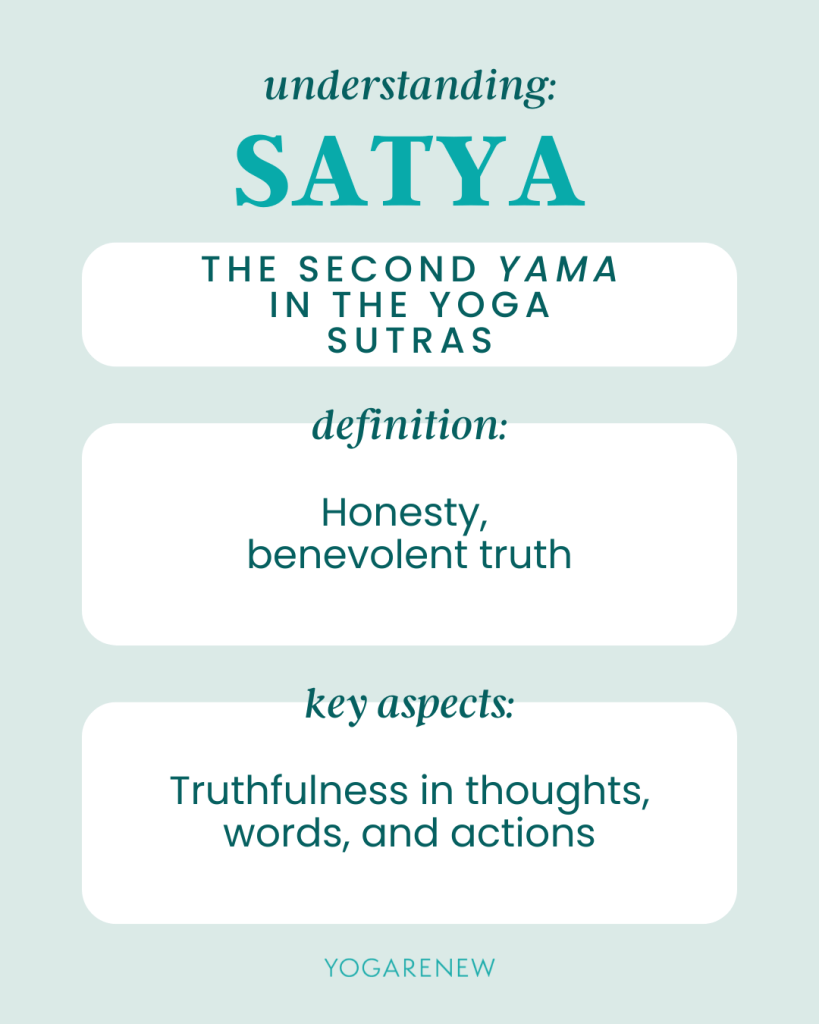
In the rich tradition of yoga, Satya holds a significant place as one of the fundamental Yamas outlined in the Yoga Sutras of Patanjali. Satya, derived from Sanskrit, translates to “truth” or “truthfulness.” This principle is not just about speaking the truth but also about living in alignment with our highest values and authentic self. In this blog post, we will explore the essence of Satya within yogic practices and how embracing this principle can transform both our yoga practice and daily life.
Understanding Satya in Yoga
Satya is the second Yama in the Yoga Sutras, following Ahimsa (non-violence). It emphasizes the importance of truthfulness in our thoughts, words, and actions. Living in truth means being honest with ourselves and others, fostering a sense of integrity and authenticity that permeates all aspects of our lives.
Satya on the Mat: Physical Practice
In the context of yoga practice, Satya encourages us to be honest about our capabilities, limitations, and intentions. Here’s how Satya can be applied on the mat:
- Honoring Your Body: Acknowledge your physical limits and avoid pushing yourself into poses that cause pain or discomfort. Practice with awareness and respect for your body’s needs.
- Authentic Practice: Focus on the quality of your practice rather than achieving a particular pose. Let go of ego-driven goals and embrace the true essence of each asana.
- Mindful Adjustments: Be truthful with yourself and your instructor about what feels right for your body. Communicate openly to ensure adjustments and modifications support your practice effectively.
Satya Beyond the Mat: Daily Life
Satya extends into every aspect of our daily lives, guiding us to live with integrity and authenticity. Here are some ways to integrate Satya into your daily routine:
- Honest Communication: Speak truthfully and kindly, avoiding deceit, exaggeration, or manipulation. Strive for clarity and transparency in your interactions.
- Living Authentically: Align your actions with your true values and beliefs. Make choices that reflect your genuine self rather than conforming to external expectations.
- Self-Reflection: Regularly assess your thoughts, actions, and motivations. Be honest with yourself about your strengths, weaknesses, and areas for growth.
Satya in Relationships
Satya fosters trust and authenticity in our relationships, creating deeper connections and mutual respect. Practicing Satya in relationships involves:
- Open Dialogue: Encourage honest and open communication with loved ones. Share your thoughts and feelings authentically, and listen actively to others.
- Trust Building: Consistently acting with integrity helps build trust and reliability in relationships. Be dependable and true to your word.
- Conflict Resolution: Address conflicts truthfully and constructively. Approach disagreements with a mindset of understanding and resolution rather than blame or deceit.
Satya and Inner Peace
Living in alignment with Satya cultivates inner peace and harmony. By embracing truthfulness, we reduce inner conflict, guilt, and stress. This authenticity allows us to live more freely and joyfully, grounded in our true selves.
The Journey of Satya
Incorporating Satya into our yogic practice and daily lives is an ongoing journey of self-discovery and growth. It challenges us to live with integrity, authenticity, and transparency, fostering deeper connections with ourselves and others. As we embrace Satya, we align more closely with the true essence of yoga—unity, harmony, and inner peace.
By living truthfully, we create a ripple effect of authenticity and trust in the world, inspiring others to join us on this transformative path. Let Satya guide you both on and off the mat, nurturing a life of integrity, connection, and inner tranquility.
Continue Reading...
Take a Journey Through the Yamas/Niyamas
Enhance your spiritual journey with incredible insight on the Yamas/Niyamas in Julie Pasqual’s immersive and transformative online course. Get started for free, and gain access to YogaRenew’s Ether app with all of our workshops, classes, series and live events.









